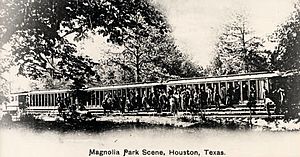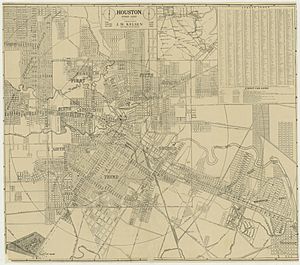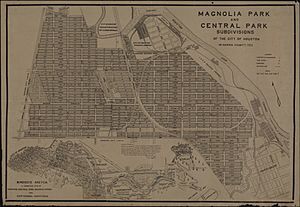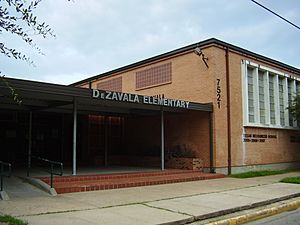Magnolia Park, Houston facts for kids
Magnolia Park is a historic area in the East End of Houston, Texas. It's located close to the Houston Ship Channel. This area is one of Houston's oldest neighborhoods with a large Hispanic population. Magnolia Park was once its own city in eastern Harris County.
Contents
History of Magnolia Park
Magnolia Park was first planned in 1890. It covered about 1,374 acres of land. This land was owned by Thomas M. Brady. The community got its name from the 3,750 magnolia trees planted by the developers.
The Magnolia Park community officially started in 1909. It became its own city in 1913. It even had its own police force.
At first, Magnolia Park was home to non-Hispanic White Americans. But in 1911, Mexican-Americans from South Texas began to move there. By the 1920s, many Mexicans escaping the Mexican Revolution settled in Magnolia Park. The building of the Houston Ship Channel and local factories attracted them.
Men worked in jobs like building the Ship Channel or in cement plants. Women found jobs in factories, stores, and textile plants.
Canal Street in Magnolia Park used to be called "German Street." Around 1918, it was renamed "Belgium Street." This was to honor Belgium, a country invaded during World War I. Later, its name was changed to Canal Street to match a street in Houston.
Magnolia Park became part of Houston in October 1926. The Mexican community stayed strong in Magnolia Park. This was partly because of unfair treatment from some Anglo residents. By 1926, people in Houston sometimes called Magnolia Park "Little Mexico." Its main business area had many shops. These included restaurants, grocery stores, and bakeries. By 1929, it was the biggest Mexican settlement in Houston.
A group called the League of United Latin American Citizens (LULAC) started a local branch in 1934. A Ladies LULAC council was also formed in 1935. By the 1930s, other groups like the Club Femenino-Chapultepec were active. They worked to fight unfair treatment and promote Mexican-American culture.
During World War II, many Mexican-Americans moved to Houston for jobs. This caused the local population to grow. By this time, some youth groups were active in Magnolia Park.
By the 1960s, many Mexican-Americans in Magnolia Park were not wealthy. However, the middle class grew thanks to programs from President of the United States Lyndon Baines Johnson. In 1971, the Magnolia Park YWCA hosted a special conference for women.
In 1978, about 20% of residents lived below the poverty line. When oil prices dropped in the 1980s, many factories closed. This caused thousands of people to lose their jobs. In 1990, Magnolia Park had 14,000 residents. The community celebrated its 100th anniversary on October 17, 2009.
Many old buildings from its history are still standing today. You can see them along Harrisburg and Canal Streets.
Community Life
In the 1920s, the area around Magnolia Park had many factories. These included industrial plants, refineries, and textile mills. They offered many job chances for people living nearby.
Population Details
In 2015, the Magnolia Park Super Neighborhood had 16,999 residents. About 95% of them were Hispanic. 3% were non-Hispanic white, and 1% were non-Hispanic black.
In 2000, the super neighborhood had 21,302 residents. About 96% were Hispanic. 3% were non-Hispanic white, and 1% were non-Hispanic black.
Local Media
In the 1970s, a newspaper called Papel Chicano had its offices in Magnolia Park. This newspaper reported on community activities in the Houston area.
Education in Magnolia Park
Students living in Magnolia Park attend schools in the Houston ISD school district.
Different parts of Magnolia Park are assigned to several elementary schools. These include Burnet, Briscoe, DeZavala, Franklin, Gallegos, and Tijerina. Edna M. Carrillo Elementary is also an option, though it is outside Magnolia Park.
All students in Magnolia Park attend Edison Middle School. For high school, some students go to Milby High School. Others are assigned to Austin High School.
School History
Originally, the area was part of the Harrisburg Independent School District. Park Junior High School opened on December 14, 1925.
A school named after Lorenzo De Zavala opened in 1926. It became the first school in Houston where most students were of Mexican heritage. At that time, Mexican students were legally supposed to attend schools for Anglo White students. However, the school district opened De Zavala Elementary because Anglo White parents were concerned about the growing number of Mexican students in the area. In 1927, the school had 576 students. Around the 1920s, school leaders made rules that students could not speak Spanish on school grounds.
In 1930, a private school called Escuela Mexicana Hidalgo opened. Its goal was to help preserve Mexican culture.
In February 1932, Park Junior High was renamed after Thomas Edison. Before the year 2000, Furr High School served much of Magnolia Park. Before 1997, students zoned to Furr could also choose to attend Austin and Milby high schools. In 1997, the school district ended this choice.
Getting Around
METRO operates the Magnolia Park Transit Center. This center is part of the METRORail Green Line.
Greyhound Bus Lines and Autobuses Americanos also have bus services here. Their bus station is next to the transit center. On December 1, 2023, Greyhound moved its services from Midtown to this bus stop.
Culture and Landmarks
Salon Juárez was built in 1928. It is a two-story building that served as a meeting place. It was used by the Sociedad Mutualista Benito Juárez. This was a mutual aid society formed in Magnolia Park in 1919.
According to Stephen Fox, an expert in architecture history, this was the city's first public building for ethnic Mexicans not built for religious reasons. The society faced money problems during the Great Depression. So, they no longer managed the building after 1932.
Over the years, the building changed owners many times. By the 1980s and 1990s, it started to have maintenance issues. The old roof was removed, but a new one was not put on. In 2004, the building was almost sold because the owner owed money in taxes. But the taxes were paid, and the owner kept the property. The Greater Houston Preservation Alliance listed it as an endangered building.
Gallery
Notable residents









